Dick Bear
|
| posted on 11/12/06 at 10:22 PM |

|
|
Open for suggestions......
12/11/06
I know it is 60ís engineering but if we can agree, for arguments sake, that ďautomotivelyĒ most everything designed today is a re-working or
refinement of what has already been designed, then you may understand my desire to fabricate a full monocoque.
In the last several weeks I have been anticipating my next build as the final touches of the McBearen are coming to an end. The physical activities
associated with that forward look on my part has resulted in many drawings and a scale model capitalizing on the knowledge and enlightenment gained
from the experience, as well as, from the many individuals who have made comments and suggestions here and elsewhere throughout the McBearen build.
Iím not going to disclose the body style of the future project just eyt but I wanted to share with you what Iíve arrived at for the tub. Except for
the three primary bulkheads I am planning to use a variety of 3/16 and 1/4Ē aluminum sheet for the tub and plan to introduce some basic static ground
effect channels where possible. Nothing too extreme but Iíve always been interested in air movement primarily as it is related to in/under and around
the bottom of a vehicle. I hope to fabricate this aspect of the build somewhat independent of the tub and body to allow adjustments in the design as
the information is gathered.
You can obviously deduct from the model that it will be a mid-engine affair with the engine oriented longitudinally. Not so obvious is the fact that
the round shape in the nose is a spare tire rather than my grandmotherís discarded hat box. <grin>
So, short of turning this into a discussion of why you like or dislike, approve or condemn a monocoque project, Iím interested in your constructive
criticism, suggestions or alerts you may have.
Cheers,
Dick Bear
 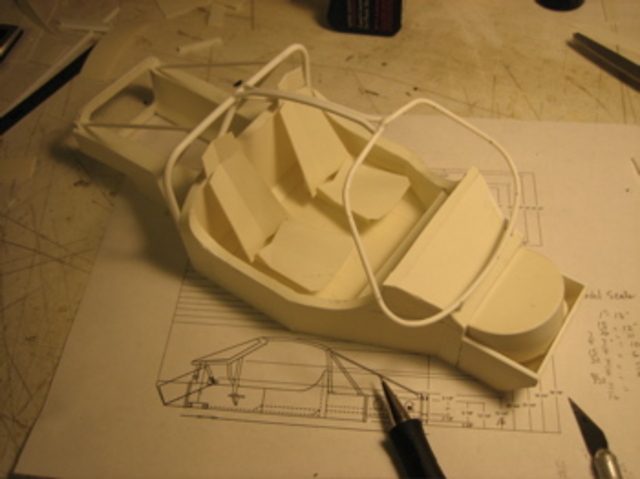
Rescued attachment IMG_0877.jpg
www.marketpointproductions.com
|
|
|
|
|
Volvorsport
|
| posted on 11/12/06 at 10:47 PM |

|
|
www.teklam.com
build it like a mosler and you wont go far wrong.
i wish with hindsight i went all out with a project like this rather than a seven type , its much easier to engineer a monocoque with a mid engine
vehicle .
www.dbsmotorsport.co.uk
getting dirty under a bus
|
|
|
chriscook
|
| posted on 11/12/06 at 10:59 PM |

|
|
I like the idea thoguh obviously can't see any detail. But generally what you must get right is the feeding of the point loads into the
monocoque structure. You may find that strategic use of steel is beneficial - corrosion problems will need to be addressed though.
Regarding your model I think I'd try and tie in the windscreen surround and roll bar structure together and into the monocoque better as this
will greatly help stiffness. This may be difficult depending on your chosen body style of course.
Chris
[Edited on 11/12/06 by chriscook]
|
|
|
MikeR
|
| posted on 11/12/06 at 11:00 PM |

|
|
I'd be interested in how you're going to pass the loads from suspension, engine, roll bar into the monocoque. This always seems to be an
issue.
Shape looks a little ultima-ish, which i suppose is obvious if youre going for a mid engined car with a roof.
Oh, if the front wheel is going where you've got it, where is the radiator going?
[edited - damn, someone types faster than me!]
[Edited on 11/12/06 by MikeR]
|
|
|
NS Dev
|
| posted on 12/12/06 at 08:10 AM |

|
|
3/16" and 1/4" ally........................................I assume longevity rather than light weight is the aim?
Retro RWD is the way forward...........automotive fabrication, car restoration, sheetmetal work, engine conversion
retro car restoration and tuning
|
|
|
TheGecko
|
| posted on 12/12/06 at 09:13 AM |

|
|
My eyes tend to skip over imperial measurements and it wasn't until NS Dev highlighted it that I noticed. 3/16" and 1/4" ??
That's 6 & 3 gauge which are (roughly) 5mm & 6mm. I'd almost start referring to ally as plate rather than sheet at those
thicknesses!
Staniforth's "Race & Rally Car Sourcebook" has some details of the Monopin - an ally monocoque version of the tube frame
Terrapin. Now admittedly it was: a race car; a single seater; powered by a bike engine (albeit a supercharged 750). The monocoque was all 18g
(that's 3/64" or 1.2mm) - 4 to 5 times lighter material!
I've scribbled a few monocoque versions of my frame. I agree with Volvosport - with a transverse mid-engine, a monocoque works very well.
After searching around on the net, everything I could find suggested that 1.6 to 2mm aluminium was sufficient - that's 16g,14g or
1/16",5/64".
The main trick seems to be feeding point loads like suspension etc into the 'coque. Have a look at some of the older formula cars on
At Speed Images for some nice photos of bracketry etc. Here's a
good example.
Hope this helps and look forward to seeing the build diary for this one.
Dominic
|
|
|
designer
|
| posted on 12/12/06 at 09:33 AM |

|
|
Your choice of alloy is far too thick.
Use thinner section and support long sections, eg side sponsons of tub, with bulkheads of sheet ally with a huge hole in the middle to stop any
lozenging.
|
|
|
James
|
| posted on 12/12/06 at 10:08 AM |

|
|
Just make sure this 'McBearan' replica has 3 seats and I'll be happy! 
...oh, and will buy a set of body panels off you....  
Cheers,
James
------------------------------------------------------------------------------------------------------------
"The fight is won or lost far away from witnesses, behind the lines, in the gym and out there on the road, long before I dance under those lights."
- Muhammad Ali
|
|
|
Dick Bear
|
| posted on 12/12/06 at 12:51 PM |

|
|
Thanks for the replies.
Judging from Mikeís and Chrisí responses the primary concern seems to be that of accommodating load transfer points for the engine and suspension and
neither of these critical issues were apparent in a quick view of a slightly out-of-focus photo of a model. Better then, that I illustrate further
what I have in mind so that we can all learn from this exercise.
Once again, letís assume here that the sheet material(s) used to form the varying plains of the monocoque structure will provide both the torsion and
structural strength equal to that of a space frame composed of welded rods and tubes. Unlike a space frame which due to its composition of like
materials (steel) makes it relatively easy to integrate the roll cage system and suspension system into the series of parallel and triangular
connections of the frame, the monocoque requires that these two systems (roll cage and suspension) be introduced as independent components to the
otherwise separate monocoque. This is due primarily because of the dissimilar metals used for each. If we were to construct the monocoque of steel
sheets there would be no issueÖ. Weíd simply weld the cage and pin the suspension where needed using steel tabs. This would work here but using steel
weíd end up with a mobile anchor defeating our primary goal of strength vs. weight.
Simply stated, when using a monocoque the issues associated with the roll cage and suspension becomes that of attachment and disbursement of forces
throughout the aluminum tub.
Here is a simplified illustration of what Iím planning at this point:
- The three primary bulkheads are indicated as green rectangles,
- Each of the tub connections will penetrate into and extend to the bottom of the tub being attached at two or more locations to the bulkheads,
- The roll bar diagonals will have their own secondary bulkheads within the rear portion of the monocoque and
- The roll bar to transom bars will function as both a compression and extension members adding support to the rear suspension connections.
Separating the roll bar system from the other elements in figure #1 illustrates how the this system functions like a truss connecting all principle
points of the vehicle from front to rear adding further strength and rigidity to the independently stable tub.
For the front suspension connections I plan to use a series of square tubes that will accept the suspension members at appropriate locations for each.
These transverse tubes will be integrated (welded) into the tub and one of the uppers and one lower tubes will also be attached to the front primary
bulkhead. The steering rack will also be located in its own transverse tube (welded in place) bringing the total number of these cross members to
five.
At the rear, two of the connections will be made at the transom bulkhead with the remaining two connections (one top and one bottom) accomplished
using the same tube configuration as described and illustrated for the front using abbreviated tub lengths since they cannot pass through the engine
compartment.
Mike asked about the radiator and itsí location. Iím working on that! May be associated with the ground effects mentioned earlier or it may be that
the spare tire has to move. Iím not sure at this point but Iím sure there will be one somewhere. J
I hope you can make-out what Iíve got planned in spite of my crude illustrations.
NOTE: although I thought I had placed this new topic in the right category, but after looking more closely Iím not sure but this should be moved to
ďmid-engineĒ. If ChrisW agrees, please feel free to move it. Sorry if I butted in where I shouldnít have!
Dick Bear
PS.... I just saw the surprises recarding 3/16-1/4" sheet (plate). That is why I asked for suggestions! 16-14 sounds better to me and its
LOcost too! Thanks.
 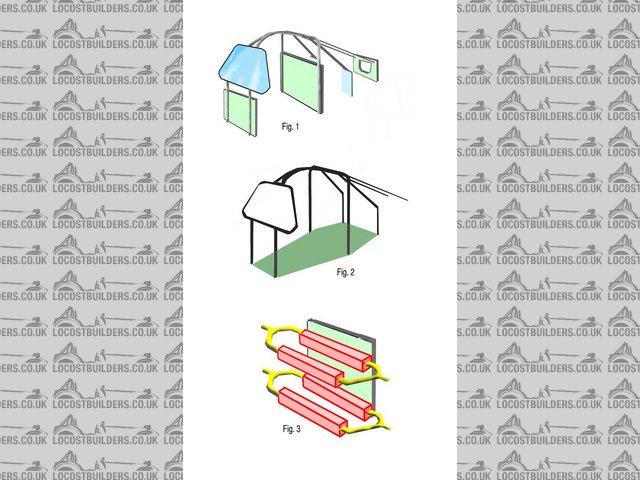
Rescued attachment roll cage illustration.jpg
www.marketpointproductions.com
|
|
|
3GEComponents
|
| posted on 12/12/06 at 01:39 PM |

|
|
Your model looks very simliar to this, having seen the McBearen, i can't wait to see this project.
Keep up the good work Dick.
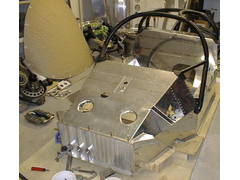 
Rescued attachment monolf03.jpg
|
|
|
3GEComponents
|
| posted on 12/12/06 at 01:41 PM |

|
|
and another
 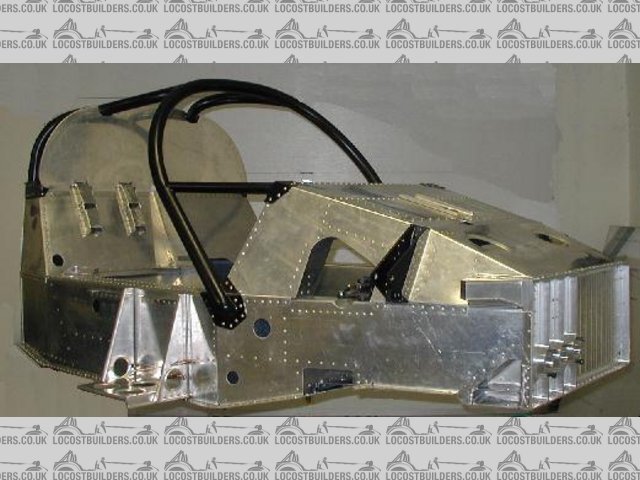
Rescued attachment m3008.jpg
|
|
|
kb58
|
| posted on 12/12/06 at 07:38 PM |

|
|
Build a scale model out of balsa. It will quickly show how torsionally rigid the proposed chassis is.
Also, there is a lot of debate about how long a stressed aluminum monocoque will last on the street. The problem is metal fatigue, which no one here
knows how to calculate. The chassis in the picture above is a real race car, and as such, it will be replaced in only a few seasons. Its lifetime,
before fatigue becomes an issue, is measured in hours, not years.
Using really thick aluminum to "buy time" will work, but the chassis will end up weighing more than a steel chassis.
[Edited on 12/12/06 by kb58]
Mid-engine Locost - http://www.midlana.com
And the book - http://www.lulu.com/shop/kurt-bilinski/midlana/paperback/product-21330662.html
Kimini - a tube-frame, carbon shell, Honda Prelude VTEC mid-engine Mini: http://www.kimini.com
And its book -
http://www.lulu.com/shop/kurt-bilinski/kimini-how-to-design-and-build-a-mid-engine-sports-car-from-scratch/paperback/product-4858803.html
|
|
|
Volvorsport
|
| posted on 12/12/06 at 08:21 PM |

|
|
well , if you followed that link to teklam - you could easily have a chassis in couple of days , you just need a router and jigsaw , just make sure
you cut it accurately .
then slot peices together and bond it up , hey presto GRP/composite/honeycomb chassis .
loads fed into the chassis with bobbins bonded in - it really is simple , your material cost could be high tho - saying that i was qouted $800 for the
materials to make one chassis , so if i get a chance i know what im doing next .
www.dbsmotorsport.co.uk
getting dirty under a bus
|
|
|
chriscook
|
| posted on 12/12/06 at 08:52 PM |

|
|
quote:
Originally posted by kb58
The problem is metal fatigue, which no one here knows how to calculate.
[Edited on 12/12/06 by kb58]
Speak for yourself!
Edited to add a: 
[Edited on 12/12/06 by chriscook]
|
|
|
kb58
|
| posted on 12/12/06 at 08:55 PM |

|
|
How many members do we have on here, 1000 perhaps? Okay, fair enough, but 99.9% still don't know how!
Mid-engine Locost - http://www.midlana.com
And the book - http://www.lulu.com/shop/kurt-bilinski/midlana/paperback/product-21330662.html
Kimini - a tube-frame, carbon shell, Honda Prelude VTEC mid-engine Mini: http://www.kimini.com
And its book -
http://www.lulu.com/shop/kurt-bilinski/kimini-how-to-design-and-build-a-mid-engine-sports-car-from-scratch/paperback/product-4858803.html
|
|
|
Alan B
|
| posted on 12/12/06 at 09:14 PM |

|
|
9061 as of a couple of minutes ago..
But, yes your point is valid.......Chris is one of a small group (I would have included myself a few years ago...but I'm a bit rusty...)
The point, I think, is like FEA, pre-preg CF, etc. monocoques don't fall readily into home building. Not impossible, obviously, but not easy or
generally recommended.
Just IMO of course.
Alan
|
|
|
NDC790
|
| posted on 12/12/06 at 11:13 PM |

|
|
Hi, i've found this thed very intresting as i was thinking along these line for my own build, but ruled it out due to cost and to the fact of my
limeted experience with ally tubs. But this has got me thinking again...........
I'm sure your familiar with the Robin Hood Lightwaight a 7 type car, it,s been about a while now, and i was assured it was heavly tested on the
road before it was released, this has a 12gage sheet constusion, with box tube riveted in, i took a close look at a show, and while i was not impresed
by the finnish, i think it's a very possible home build, if you got the design right.
I would also compair this to the Lotus Elise/Exige chassis, I work (loosly) at a Lotus spicalist, so i've climbed all over these cars, ally tub,
extruded tube everywhere, gavanized steel rear subframe, the only thing i dont think could be replicated is the baked bonding (which i no nothing
about) which I'm told is a very expencive material and prosess. I'll try and get some pic's of the Lotus chassis up, I also hve some
experience with the Morgan Areo8, which has a simular chassis construction.
I think with time and a bit of thought it's very possible, IMHO.
 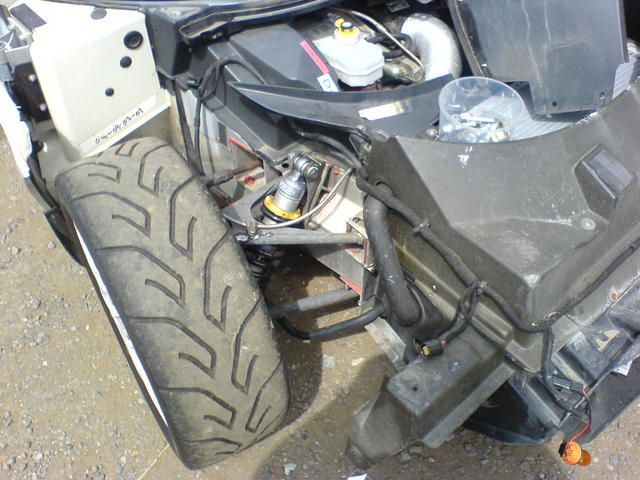
Rescued attachment Picture 021.jpg
|
|
|
chriscook
|
| posted on 12/12/06 at 11:23 PM |

|
|
Meant to add one of these >>>> 
Doing the fatigue analysis on that chassis would be challenging to say the least. Even if you could get hold of decent material properties, realistic
loads, create suitable dynamic and FE models. Even then the best result could be within a factor of 2 for life.
To say doing a full fatigue analysis is beyond the home build is absolutely correct - it's beyond many car manufacturers! (And I'm
certainly not saying I could do it all either)
[Edited on 12/12/06 by chriscook]
|
|
|
Dick Bear
|
| posted on 13/12/06 at 01:41 AM |

|
|
material fatique
I hear you guys.... but from a practical standpoint how many of us know or are able calculate the fatigue factor associated with anything we build.
It's really a non-issue when with several hundred welded connections in a space frame (none having been tested) are created by an equal number
of individuals each posessing different welding skills are driven on the street, raced and enjoyed everyday successfully.
One can only assume that the basic technology resulting in aircraft flying overhead today, tho' built 30, 40 and even 50 years ago, is
technology suitable for building an experimental auto monocoque suitable for a few hours of driving enjoyment each year.
In reality none of the projects we build can be quaranteed against failures of one sort or another. The best we can do is attempt to anticipate
adjust to what we percieve as a weak point or problem by reinforcing those areas.
To do nothing because we're unable to move the slide rule expertly enough to figure conclusively every bit of information we might want to know
about a structure is not our mission nor should it be an excuse not to explore new areas for having fun!
Some may feel that because they heard something, somewhere about metal fatique we should all limit ourselves to producing our dreams with only hollow
tubes of steel and that that is where our safe zone should terminate.
Come on ... You guys are building competition type vehicles for goodness sakes. Everytime you strap on your helmet and head into a corner you take
more risk than someone does builging a monocoque tub while following generally recognized precautionary design proceedures.
METAL FATIGUE, yes metal does fatigue. In fact it also rusts, bends and cracks and snaps under certain conditions. So what? Isn't
that's the intrique of what we are doing.
Attempting to build a reliable monocoque is just an another avenue of interest that I can't ignore simply because I'm unable to calculate
everything relating to doing so, mathmatically. I admire math-whizzes but if I had always limited myself to addressing only those things that I could
"mathimatize" I'd have never done anything in my life.
So.... what else can you enlighten us all with conserning the design and building of a monocoque?
Dick Bear
[Edited on 13/12/06 by Dick Bear]
www.marketpointproductions.com
|
|
|
kb58
|
| posted on 13/12/06 at 03:03 AM |

|
|
quote:
Originally posted by Dick Bear
METAL FATIGUE, yes metal does fatigue. In fact it also rusts, bends and cracks and snaps under certain conditions. So what? Isn't
that's the intrique of what we are doing.
I guess I though that some science could be applied to this. You know, use what people have learned before us; learn from other people's
mistakes. Aluminum does work-harden, and you know this better than most people. When you're working an aluminum panel, you have to keep
annealing it or it cracks.
Mid-engine Locost - http://www.midlana.com
And the book - http://www.lulu.com/shop/kurt-bilinski/midlana/paperback/product-21330662.html
Kimini - a tube-frame, carbon shell, Honda Prelude VTEC mid-engine Mini: http://www.kimini.com
And its book -
http://www.lulu.com/shop/kurt-bilinski/kimini-how-to-design-and-build-a-mid-engine-sports-car-from-scratch/paperback/product-4858803.html
|
|
|
Syd Bridge
|
| posted on 13/12/06 at 09:21 AM |

|
|
This whole materials thing needs to be put into perspective.
Some of my 'bread and butter' comes from designing and building monocoques, in various forms and materials.
The racecars that are still built in ali are certainly lifed, but usually come to grief well short of that.  Lotus saw fit to do their modern cars
with ali mono's, so for specialist applications, it's ok. Lotus saw fit to do their modern cars
with ali mono's, so for specialist applications, it's ok.
We'll rule out carbon, because without the proper gear (autoclaves, car size ovens and such), and the tooling costs, it is not worthwhile for
home/garage builds. And not done properly (this means NO wet layups!!!!), can fail catastrophically.
I've seen no mention of steel sheet mono's here yet. Why not? After all, your car is a steel mono. A home build steel mono can end up much
better than a spaceframe, and lighter when you factor in the panelling of the spaceframe. After all, the sheet mono is only the panelled spaceframe,
without the tubes!
I did a prototype project for a local company a good few years ago. When all the numbers were crunched, and 'street cred' and sales value
were factored in, the decision to go with a 1.2mm stainless sheet mono was easy.
Not the lightest, but easily built with a mig welder and the basic cutting and bending gear that was to hand.
The stainless sheet will last forever, is not too difficult to work with, and relatively easily patched without special welding or any other tools.
If I were Dick Bear, I'd be having a serious look at a thin sheet ss mono. ~1mm plus stiffeners strategically placed.
Cheers,
Syd. 
Edit: I just reread some of the above posts. For the ali bonding adhesive, Bondmaster do a 'filled epoxy' one part that is cured at 120c.
All the glue companies do a similar product. You'll tear the ali before the glue lets go........... that's if you've prepped the ali
properly in the first place. Not expensive at all, just the oven costs a bit. 
[Edited on 13/12/06 by Syd Bridge]
|
|
|
Hammerhead
|
| posted on 13/12/06 at 02:22 PM |

|
|
I would deffinately take a look at the lotus elise chassis. There are plenty of pics online. The part of the chassis that may interest you most is the
extruded beams that form the mainstay of the chassis.
I am interested in building a carbon/kevlar monocoque chassis. and I thank Dick for his comments which amount to 'GO FOR IT!' However Syds
comments about 'No wet layup' for a cf mono make me worried.
I have experiance with CF rowing boats. These hold eight people and weigh very little. The weight of the men rowing such boats is 800kg ish. And the
force exerted by the crew to move the boat is around 1000kg of force, much of which is exerted on the hull of the boat.
My point being, that these boats are made with a wet layup, which is vacuum bagged with the only addition of heat from infra red heat lamps.
My intention is to use the same technique as the boat builder to build a cf monocoque for a car.
|
|
|
kb58
|
| posted on 13/12/06 at 02:41 PM |

|
|
Nuts, Syd Bridge beat me to it. I was thinking that myself, why not a steel monocoque? It has a lot of appeal and I'd consider that, just not
aluminum!
Mid-engine Locost - http://www.midlana.com
And the book - http://www.lulu.com/shop/kurt-bilinski/midlana/paperback/product-21330662.html
Kimini - a tube-frame, carbon shell, Honda Prelude VTEC mid-engine Mini: http://www.kimini.com
And its book -
http://www.lulu.com/shop/kurt-bilinski/kimini-how-to-design-and-build-a-mid-engine-sports-car-from-scratch/paperback/product-4858803.html
|
|
|
Dick Bear
|
| posted on 13/12/06 at 03:50 PM |

|
|
SSteel? Thanks Syd that has a geat appeal! All the benefits of aluminum and steel rolled into one. Great suggestion!
I will explore that idea further.....
Dick Bear
www.marketpointproductions.com
|
|
|
Syd Bridge
|
| posted on 13/12/06 at 06:00 PM |

|
|
Dick,
You can work well with metal sheet, obviously. So, the ss monocoque tub with the ali skin should be a very worthwhile proposition. I wouldn't
mind it myself!
If you need any design tips, give me a yell.
Hammerhead,
A rowing boat is supported on its entire surface, and the only point loads and local highs are near the oars. The seats are supported over a good
length. So, no high local loadings. A car tub is a very different animal. The wet layup will have excess resin and the possibility of resin rich
areas, where the laminates are not homogeneous. Sources of the catastrophes! I've seen far too many failures in racing yachts built just as
you describe, to not even contemplate a car tub. Do it with prepreg and an autoclave, or not at all!!!!!!Well, if you want to live a long life,
anyway. 
Cheers,
Syd. 
Edit: I'll add, re carbon mono's-----The layup needs to have a good percentage of unidirectional content, and this is
extremely difficult to wet out without being prepregged.
[Edited on 13/12/06 by Syd Bridge]
|
|
|









